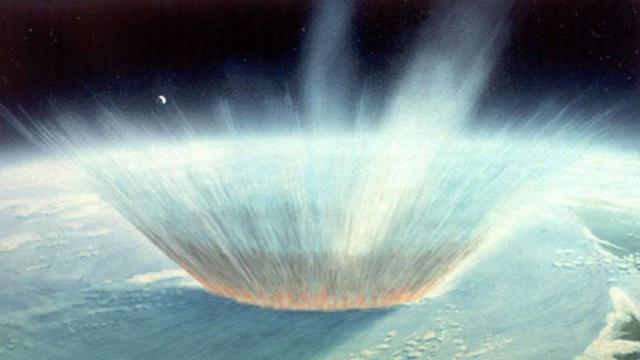When a gigantic asteroid struck the Earth some 66 million years ago, it triggered an “impact winter” that extinguished over 75 per cent of all species on Earth. New research suggests it was the resulting low light, and not frigid temperatures, that drove this horrific mass extinction.
The Cretaceous–Paleogene (K–Pg) mass extinction event was so bad that no terrestrial species larger than a rat managed to survive—and it stayed that way for hundreds of thousands of years. It was the resulting impact winter that did the damage, as the atmosphere became inundated with dust, sulfuric compounds, and soot, which caused low temperatures and a dramatic lack of sunlight.
As to which factor—the low light or low temperatures—contributed the most to the impact winter and the ensuing mass extinction is a matter of debate. New research published in Geophysical Research Letters attributes the low light—as caused by excessive soot in the atmosphere—as the primary factor. The new paper was co-authored by geoscientist Clay Tabor from the University of Connecticut, and his colleagues from the University of Colorado, Boulder, and the National Centre for Atmospheric Research.
For the study, the researchers ran multiple simulations showing how the Earth’s climate reacted to the dramatic addition of all that stuff in the atmosphere. When the asteroid struck, it spewed an unspeakable amount of molten material into the sky, which fell down as fiery rain across much of the globe. This kindled massive wildfires around the world, the byproduct of which was soot, and lots of it. As for the dust and sulfates, those elements came from the collision itself (asteroids are packed with sulphur). To create the simulations, the researchers used the Community Earth System Model (DESM) which is “able to accurately simulate present‐day climate and has been widely used for paleoclimate applications,” according to the study.
Consistent with other research, the models showed that the reduced sunlight caused global cooling at the Earth’s surface. Yes, this cooling was bad, the researchers admit, but not enough to tip the scales towards a mass extinction.
As for the low light impacting on the Earth’s biosphere, that’s another story. According to the models, the soot hung out in the atmosphere for a protracted period of time. And unlike dust and sulphur, soot sucks up the Sun’s life-giving rays like a sponge.
“Based on the properties of soot and its ability to effectively absorb incoming sunlight, it did a very good job at blocking sunlight from reaching the surface,” explained Tabor in a press release. “In comparison to the dust, which didn’t stay in the atmosphere for nearly as long, and the sulphur, which didn’t block as much light, the soot could actually block almost all light from reaching the surface for at least a year.”
Think about that. Our Earth was dark for an entire year.
As a result, photosynthesis on the planet dropped to less than one per cent of what it was before the impact. This prevented the growth of organisms at the base of the food web, such as photosynthesizing plants, algae, and microorganisms (like phytoplankton). The collapse of the foodweb soon followed, given the importance of these food sources to other animals.
“This low light seems to be a really big signal that would potentially be devastating to life,” said Tabor “It seems like these low light conditions are a probable explanation for a large part of the extinction.”
The new paper shows the previously understated importance of soot in the mass extinction that followed the Chicxulub impact, which happened in the Yucatan Peninsula.
“It’s interesting that in their model, soot doesn’t necessarily cause a much larger cooling when compared [to] other types of aerosol particles produced by the impact,” explained Manoj Joshi, a professor at the University of East Anglia in the U.K. in the press release. “But soot does cause surface sunlight to decline a lot more,” said Joshi, who wasn’t involved with the research
Fascinatingly, the new research points to both the Arctic and Antarctica as possible safe spaces for life during this trying time, particularly the polar coasts and surrounding oceans. The reason is that these regions already go through periodic cooling periods, along with experiencing prolonged bouts of sunlight. What’s more, organisms at the higher latitudes are already well adapted to extreme shifts in temperature, according to the research.
[referenced url=” thumb=” title=” excerpt=”]
As always, it’s never a good idea to attribute a single cause to such a dramatic event. Clearly, the asteroid impact set off a cascade of despair, and as previous research has shown, volcanoes that erupted around the time of the impact didn’t help either. That said, the new paper presents a compelling case, in which a very important domino—the base of the food web—fell over due to a dearth of sunlight, setting off a dramatic chain of events the led to the (K–Pg) mass extinction.
